Act One: April 25, 1988, on the Bom Jardim River, a tributary on the right bank of the Xingu River. Boats dock at the federal Indigenous affairs agency post. Some fifteen men disembark with jamaxi packs on their backs and bows and arrows in their hands. They begin walking in a straight line up toward the village. They had departed one week earlier to see if the rumors were true about timber being extracted near the Bom Jardim’s headwaters – mahogany, to be exact, the organic gold of the 1980s and 1990s. While I was photographing the Apyterewa-Parakanã’s arrival, I noticed two strangers in the group who were visibly anxious. The Indigenous people had apprehended two timber company employees, so that the Funai, the Indigenous affairs agency, could take “appropriate measures.”
At that time, having been contacted by outsiders just four years earlier, in 1984, the Apyterewa-Parakanã, who spoke no Portuguese, left it to Funai to resolve the situation. Funai ended up selling part of the mahogany to the very same timber companies. The two apprehended employees were exchanged for 140 hammocks and 140 mosquito nets. Later, using resources obtained to carry out a delimitation study of the Apyterewa-Parakanã territory, Funai recognized an area of 980,000 hectares, less than 1% of the state of Pará, as Indigenous territory. In 1992, Célio Borja, then the Minister of Justice, signed the demarcation directive.
Final Act: October 2, 2023. Official start of the operation to remove intruders from Apyterewa Indigenous Territory and Trincheira-Bacajá Indigenous Territory. It is reported in the press:
“Government hesitates to expel invaders from Apyterewa Indigenous Territory, the country’s most deforested”
(Rubens Valente, Agência Pública, September 27, 2023).
“Invaders have built a villa, church, mining operation and already outnumber Indigenous people in legal reserve in Pará”
(Carol Castro, Intercept Brasil, September 27, 2023).
Security forces begin biggest removal of invaders from Indigenous lands in Pará. The Apyterewa Indigenous Territory, belonging to the Parakanã people, lost 324 km² of forest […]”
(Daniel Biasetto, O Globo, October 2, 2023).
Reading these headlines, it’s impossible not to wonder what went wrong in these thirty-five years between these two acts. How did theft of timber become theft of land? How was a social conflict situation established involving multiple actors, including herds of cattle? The case of the Apyterewa is one example where history seems to repeat itself in a concentrated way: 500 years in a few decades. It has everything: gold and timber extraction, forced labor, churches and missionaries in Indigenous villages, invaders on Indigenous lands who become politicians, politicians who become farmers, cows and deforestation, gigantic development projects, poorly made settlements – and poverty, of course, lots of poverty.
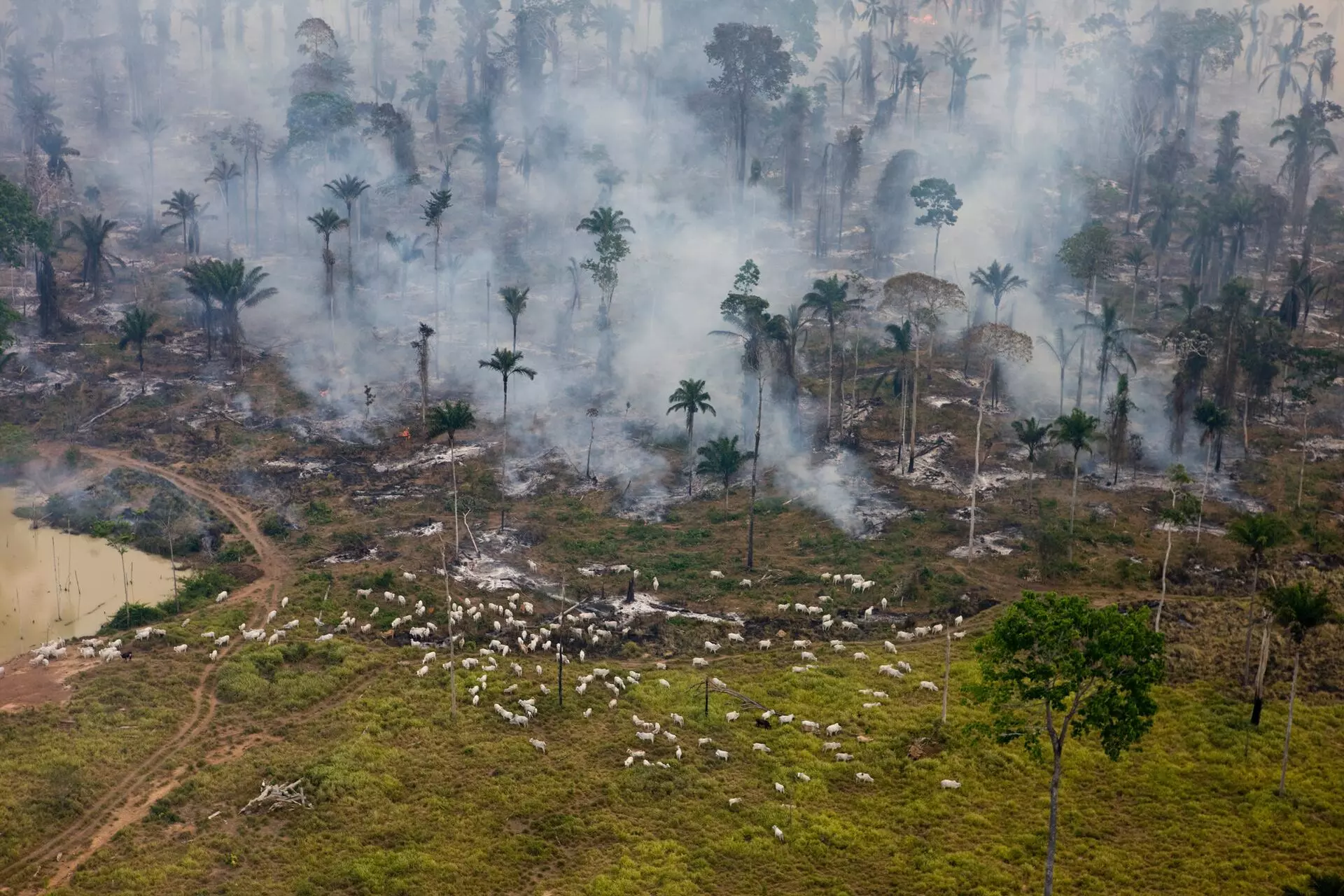
Forest fires, mostly human-caused to prepare pasturelands, lay waste to the land in São Félix do Xingu. Foto: Daniel Beltrá/Greenpeace
How did we get here, after all? It’s a long story and one I’ve been following for thirty-five years, starting from the first time I came to Altamira, in February of 1988, to do ethnographic research among the Apyterewa-Parakanã, and up to today.
In 1988, Altamira was an expectant city. Its people were waiting for the Trans-Amazonian Highway to be paved, and for the construction of the Xingu Hydroelectric Complex (Altamira Hydroelectric Complex). The city, whose demographics would swell with the opening of the highway in the 1970s, existed in a slow burn. “Development” lay straight ahead – this was certain, everyone knew. Yet nobody ventured to wager when it would arrive.
One night, still in 1988, I remember walking by an empty bar with a color TV. I stopped and stared at the screen, where I could see dozens of Kayapó painted with genipap were in the galleries of the National Congress. It was during the final months of the Constituent Assembly and Article 231, which covers Indigenous peoples, was up for discussion. At the time, those images filled us with hope.
With the enactment of the Constitution, it seemed the dictatorship had finally been left behind. A few months later, in February 1989, Altamira would host the “First Meeting of Xingu Indigenous Peoples,” the high point of resistance against the construction of the Hydroelectric Complex. The cold blade of Tuire Kayapó’s knife, flat against the face of Eletronorte’s director, would become iconic in the fight against the river’s damming. For many years, we thought we had definitively won. But that initial project called Kararaô made Belo Monte – and we already know the rest.
For those at the tip, however, hope clashed with reality. Five hundred kilometers straight south of Altamira, mahogany hunting ran rampant. Exploration of timber in the region was the result of a colonization project carried out during the military dictatorship by the Andrade Gutierrez construction company, from 1982 to 1985. By the end of that decade, the project had turned the sleepy town of Tucumã into a city of 20,000 inhabitants. The high prices mahogany was fetching on the international market led to dizzying growth in predatory extraction. Record volumes of timber were processed in the mills of Tucumã and Redenção from 1986 to 1994. Most of this wood was illegally removed from Indigenous territories in the region, including Apyterewa territory.
This invasion was led by two large companies: Exportadora Peracchi and Madeireira Araguaia (Maginco). The road they built — which would receive the romantic moniker of “Morada do Sol” — began to cut through Indigenous territories in 1987. The road left Tucumã, crossing 100 kilometers before it reached the São José River and continued for another 100 kilometers into the Apyterewa, Araweté, and Trincheira-Bacajá Indigenous Territories. It was at precisely this moment that the Apyterewa noticed the invasion and apprehended two men. Although the agreement between the Funai and the timber companies guaranteed funding for the work of delimiting the area, it ended up officializing the illegal sale of the timber apprehended by the government agency to the very same people who were breaking the law. The Apyterewa-Parakanã continued to carry out expeditions into the invaded areas, pillaging campsites and “visiting” the “Pé-do-Morro” farm in Peracchi.
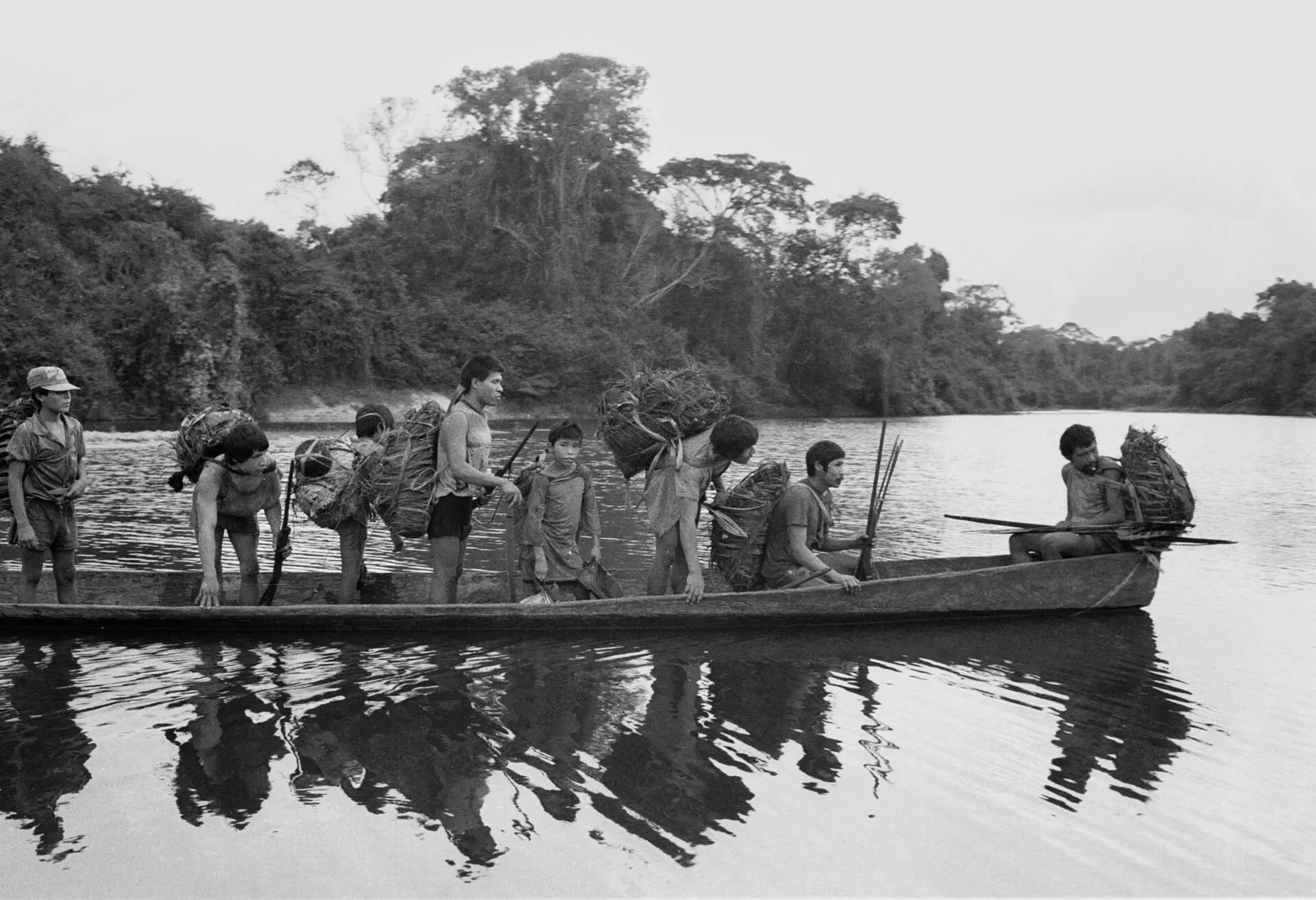
Indigenous peoples docking at the Apyterewa Post, upon returning from a surveillance expedition organized in 1993. Photo: Carlos Fausto
National and international pressure against the predatory exploration of mahogany would grow in the subsequent years, taking on a high profile at the 1992 Earth Summit in Rio de Janeiro. That same year, a ministerial directive was issued that recognized permanent ownership of the Apyterewa Indigenous Territory. In the wake of the directive, oversight operations began at Funai as well as at the environmental agency, Ibama, and the Federal Police. Under pressure, the companies reacted strategically: they opened access to the Indigenous area from the road they had built and facilitated its invasion, forging a scenario of social conflict. Making matters worse, in 1994 the country’s agrarian reform agency, Incra, created a resettlement area within the same Indigenous territory – at exactly the same time as Funai was trying to physically demarcate the area for the first time.
In 1996, I coordinated a Working Group that carried out additional studies on the Apyterewa Indigenous Territory. At that time, I was able to review the original anthropological report, which is now being contested by the invaders. We concluded that it had no original defects and was in accordance with events and with the Federal Constitution. An analysis of the information provided by the defendants, landgrabbers and timber companies, shows that nearly every non-Indigenous resident arrived in the area after 1990 – with 65% arriving after 1992. These numbers clearly show the more-than-recent presence of the majority of the invaders. At the time, under the Fernando Henrique Cardoso administration and with the support of the Federal Public Prosecutor’s Office, we even discussed possible solutions to the impasse with the Ministry of Justice and the Ministry of Land Management Policy, but it was useless. There was neither political will from the government, nor interest from the landgrabbers, farmers, and local politicians to resolve the problem. The less conciliation, the greater the chance to expand the invaded area.
The Apyterewa Indigenous Territory fell into limbo. Demarcation was not a priority, paperwork was slowly shuffled around in Brasília, the invasions continued and young Indigenous leaders became frequent visitors to the world of the invaders in São Félix do Xingu and Altamira. Temptation spread far and wide and life kept moving on. Nearly a decade later, a resuscitated developmentalist wave would drag the Parakanã down into a new whirlpool. Now overhauled as the Belo Monte, the old Godzilla monster again rose from the waters, now at the hands of a Workers’ Party government. With this, civil society and the Indigenous people were unable to stop the dam. Belo Monte would be built with all of the expected negative social and environmental impacts – and many more.
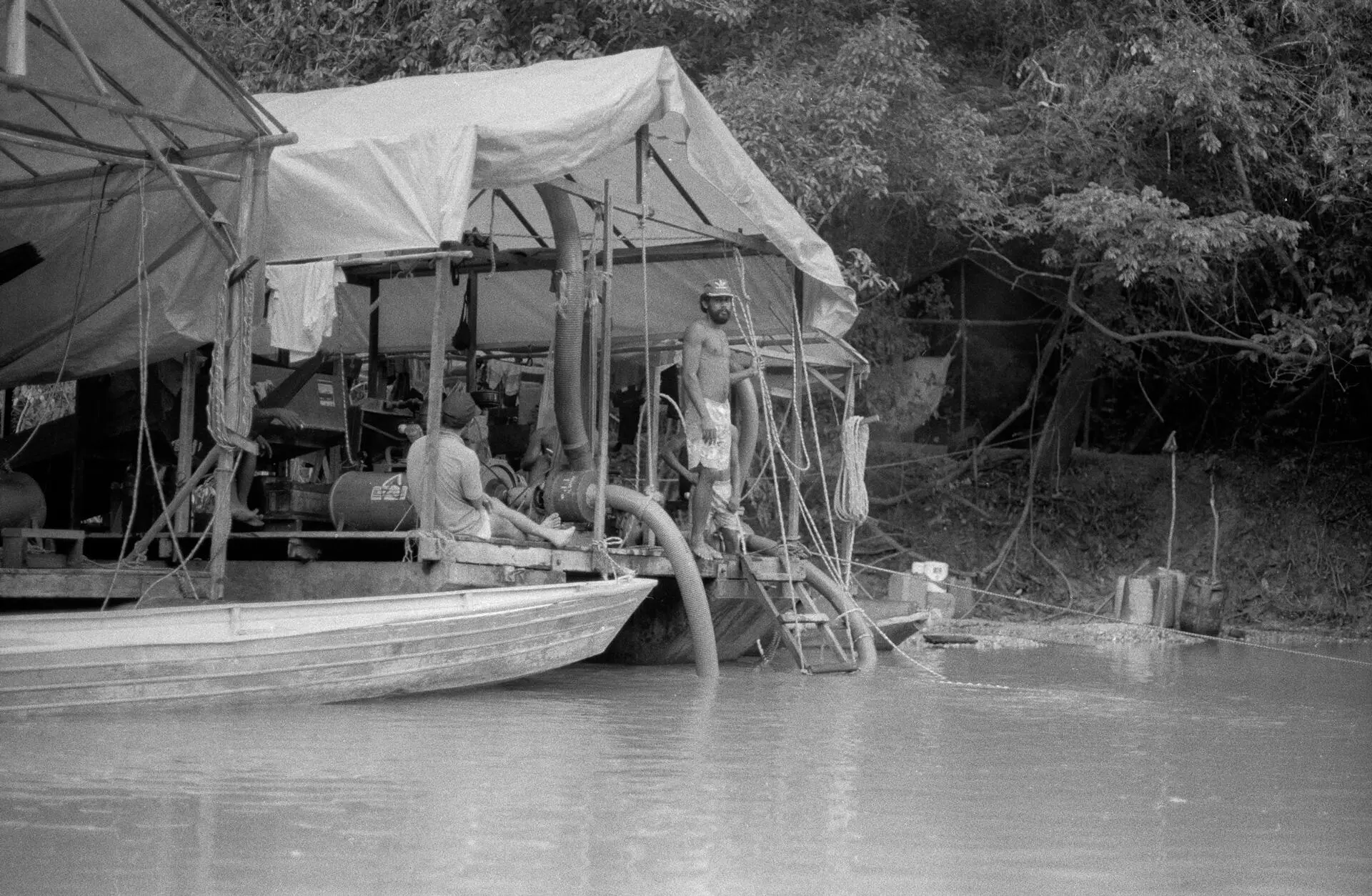
In the late 1980s, illegal mining operations had already been set up within Apyterewa Indigenous territory. This picture was taken in 1989, on the São Sebastião River. Photo: Carlos Fausto
In 2015, I was in Altamira doing a photographic report on the urban transformations caused by the project. The city that I had known had changed completely. Not just because of the construction of so-called RUCs (the acronym in Portuguese for the Collective Urban Resettlements) and the elimination of stilt houses in the lowlands, but also because of a boom in businesses serving the engineers whose pockets overflowed with cash and dam workers whose pockets were empty, some of them buying Veuve Clicquot at the gas station convenience store (I’m serious!), others passed out on the dock, after using a day off to get drop-down drunk on cachaça.
The money flowing freely along with the city’s sewage also reached the Indigenous peoples. There was a sort of allowance for each village – and saying they fragmented and multiplied isn’t even necessary. Modern fishing boats were purchased and later sold for half their value to local transport companies. The easy money flowed through leaders’ hands. There were no projects and few plans for the future.
There was, however, one condition for building the Belo Monte Dam that interested the Apyterewa-Parakanã: demarcation and removal of intruders from their territory. In 2005, the Indigenous Territory was administratively demarcated (according to the administrative process) with 773,000 hectares (around 200,000 hectares less than the initial borders). Two years later, it was ratified by Brazil’s president. Yet the invaders were not removed. They wanted – and still want – half, yes half, of a ratified Indigenous territory.
This October, during week one of the operation, I saw some very strange posts circulating on social media. One of them shows a dirt road and a group of women and children. In bold letters it says “SOS Apyterewa” and “Children ask UN for humanitarian help,” with “Apyterewa asks for help” in smaller letters. For a second, I was wondering who was asking for help: the Apyterewa? I pressed play and was able to make out the banner the demonstrators were carrying. It said: “SOS UN | Vila Renascer asks for humanitarian help | Children, women, and farmers in the Apyterewa extension ask for UN help.”
Vila Renascer emerged in 2016 and is located inside of the Apyterewa Indigenous Territory. It is, in fact, a recent chapter of the story told here. The populated area is strategically called the “Apyterewa extension” by the invaders. As the banner states, it isn’t just adults and kids living in this extension, but “children, women, and rural producers” – an expression that shows just as much as it hides: it joins the idea of production with the rural medium, while forgetting to mention that these are illegal activities and the rural part is, actually, a forest. It forgets to mention that there is also an estimated 60,000 head of cattle living there, a herd that entered the Apyterewa Indigenous Territory illegally and which is also taken from the territory illegally to enter the production chains of major meatpackers, who in turn guarantee that they only work with cattle that have certified origins.
It’s easy to understand how we reached this social crisis scenario since that first incursion by the Apyterewa-Parakanã into the headwaters of the Bom Jardim River, way back in 1988. Along the way, there was no lack of opportunities to bring peace to the frontier. Instead there was a choice to continue reproducing poverty and creating ruin. The ruin of the forest and its inhabitants, the ruin of us all.
“Fifteen areas with cattle herds were also identified during the day, in addition to stopping ten vehicles carrying 199 animals within Indigenous territory.” (Report on Removal of Intruders from the Apyterewa and Trincheira-Bacajá Indigenous Territory – Oct. 3, 2023)
“On day three of the Operation […], a team was at the Sol Nascente Farm and found Antônio Borges Belfort, a farmer identified as an employer who had an employee working in a forced labor situation.” (Report on Removal of Intruders from the Apyterewa and Trincheira-Bacajá Indigenous Territory – Oct. 4, 2023)
“At Vila do Piranha, […] police forces detained a man for illegal possession of weapons and drugs in the region. Police also stopped a cattle truck and found the driver was carrying amphetamines (Amfepramone).” (Report on Removal of Intruders from the Apyterewa and Trincheira-Bacajá Indigenous Territory – Oct. 4, 2023)
“During monitoring by CENSIPAM [the Amazon Protection System Management and Operations Center], a deforested area equal to 1,000 football pitches was found within the Apyterewa Indigenous Territory. […] Ibama [the environmental protection agency] is starting to investigate the possibility that this deforestation was done using a defoliant, an agrotoxin hazardous to the land and people.” (Report on Removal of Intruders from the Apyterewa and Trincheira-Bacajá Indigenous Territory – Oct. 6, 2023)
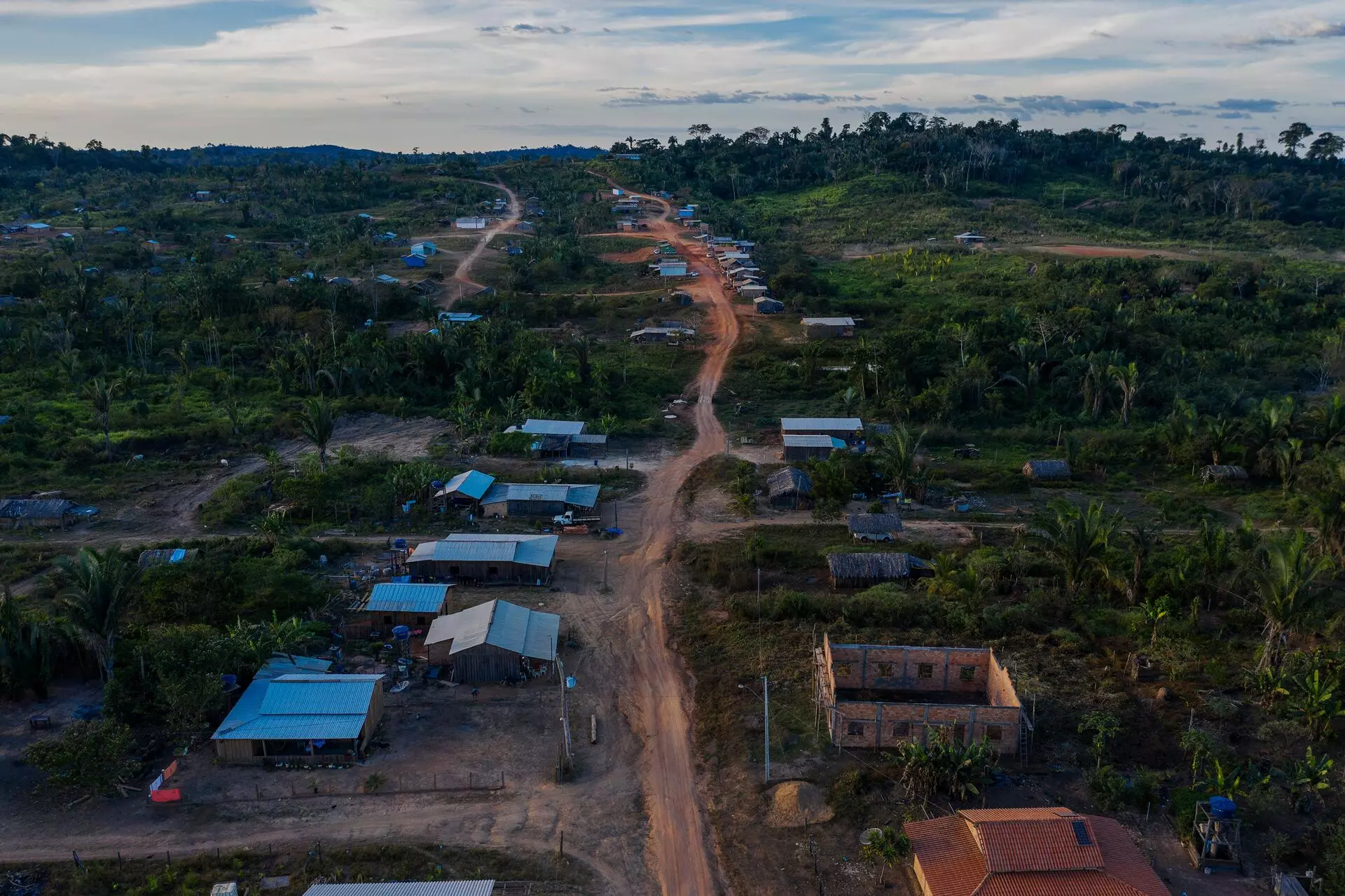
The invaders have moved into Vila Renascer, in São Félix do Xingu, inside of the Apyterewa Indigenous Territory, in the state of Pará. Photo: Lalo de Almeida/Folhapress
Because it could be no other way, politics were – and continue to be – a central node in this story. With each electoral cycle, especially elections for municipal council members and mayors, the invasion of the Apyterewa Indigenous Territory grew and grew. At the end of the last century, the state’s main oligarch was Jader Barbalho (Brazilian Democratic Movement), who was known for having little inclination to demarcate Indigenous lands. It was, in fact, his administration that filed for a writ of mandamus to nullify the demarcation directives issued by the Ministry of Justice in relation to the Rio Paru d’Este, Trincheira-Bacajá, Araweté, Koatinemo and, of course, Apyterewa Indigenous Territories. Fortunately, in 1994, the Superior Court of Justice completely refused the writ.
Today, his son, Helder Barbalho, is the governor of Pará. He also seems to have little appreciation for the Indigenous cause. His administration was as an amicus curiae (friend of the court) of São Félix do Xingu in the filing to nullify the Apyterewa Indigenous Territory, which the Federal Supreme Court denied in 2022. Now, according to press reports, he has been working closely with state deputy Torrinho Torres (Podemos) and São Félix’s mayor, João Cleber (Brazilian Democratic Movement), to halt the operation to remove intruders. Hence the hesitation from the federal government to start the operation, setting a longer deadline for its conclusion.
Governor Helder Barbalho is trying to balance his new garb as a leader on sustainability in the North region with the local interests of his political supporters, many of them agents of deforestation and invasion of Indigenous territories. All that remains to know is whether he will be capable of keeping this double-dealing going. Depending on how he acts in the case of the Apyterewa Indigenous Territory, his ESG (Environmental and Social Governance) badge will or will not disappear: yet another example of greenwashing or an effective commitment to sustainability?
Holding back the advancing borders of deforestation in southern Pará is essential to the future of the Amazon Rainforest. Deforestation in the Apyterewa Indigenous Territory kept pace with the downward trend in the rest of the Amazon, reaching its lowest level in 2012. As of 2018 it again exploded, reaching alarming levels over the next four years. The Indigenous people are finding themselves increasingly confined to a fraction of their permanently held territory. Its position as the southernmost area of a complex of Indigenous territories ensuring the preservation of the right bank of the Middle Xingu River makes the Apyterewa Indigenous Territory strategic. Without it, the entire system protecting the forest is weaker. If removing the intruders doesn’t work this time, the borders of the deforestation will continue to mercilessly march forward.
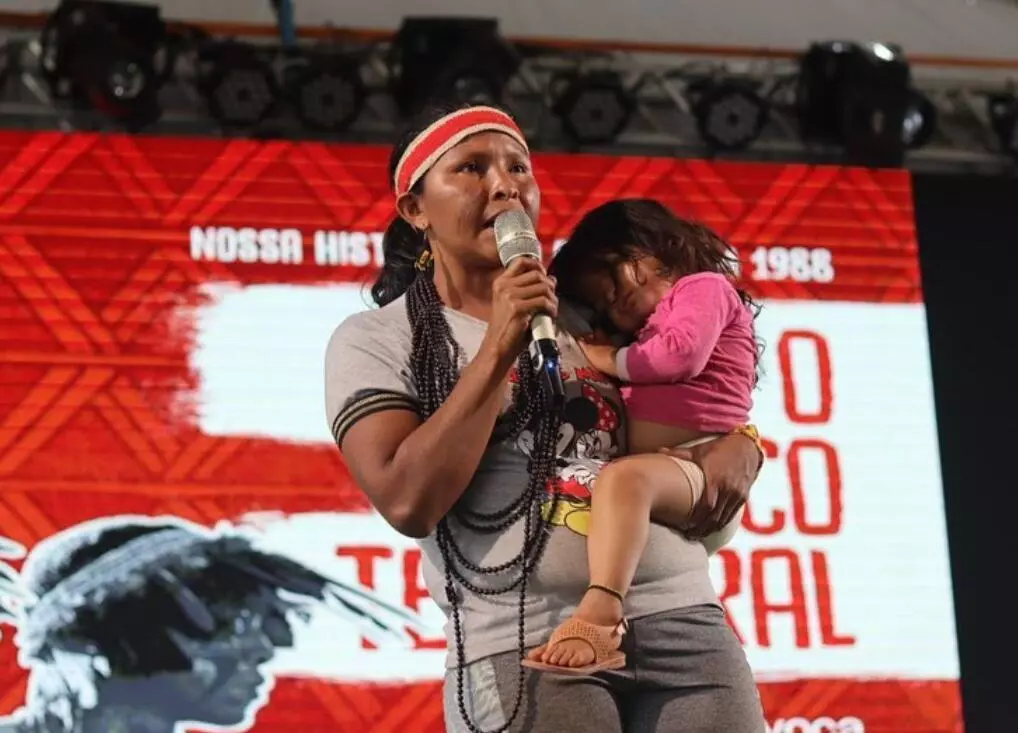
Wenatoa Parakanã, president of the Tato’a Indigenous Association, speaks at the Free Land Camp, in May 2023. Photo: Sérgio Pamaãn Suruí/Young Indigenous Communicators Network of the Coordination of the Indigenous Organizations of the Brazilian Amazon (COIAB)
On October 4, the Tato’a Indigenous Association, which represents the Apyterewa-Parakanã, released a letter addressed to the competent authorities, signed by the Association’s president, Wenatoa Parakanã, and dozens of members. The letter calls attention to attempts made by invaders to entice community members, pointing to a series of court rulings supporting the removal of intruders. They end by asking for the operation to be concluded so that they may “live free in our own territory.”
In recent years, the Apyterewa-Parakanã have taken part in dozens of meetings and hearings in Brasília with the Supreme Court, the Secretary to the President, the Ministry of Indigenous Peoples, the Ministry of Indigenous Peoples, the Funai, and other agencies. It has been up to Supreme Court Justice Luís Roberto Barroso to order the removal of intruders, forcing the government to submit a plan to remove the invaders. Today there is only an on-going operation to remove intruders because of the assistance of several organizations, the political will of various actors, the work of countless supporters, and especially the learnings of the Apyterewa-Parakanã in continually reinventing themselves through so many battles, many of which were lost. If they win this one, they have promised to hold a big Opetymo, the “Tobacco Ritual,” and, of course, invite Lula and Barroso to the celebration.
Carlos Fausto is an anthropologist, photographer and documentary filmmaker, a professor at the National Museum at the Federal University of Rio de Janeiro, a researcher with the CNPq, and a Princeton University Global Scholar.
Proofreader (Portuguese): Valquíria Della Pozza
Spanish translation: Julieta Sueldo Boedo
English translation: Sarah J. Johnson
Photo Editor: Lela Beltrão
Layout and finishing: Érica Saboya
Editorial workflow and copy editing: Viviane Zandonadi
Director: Eliane Brum
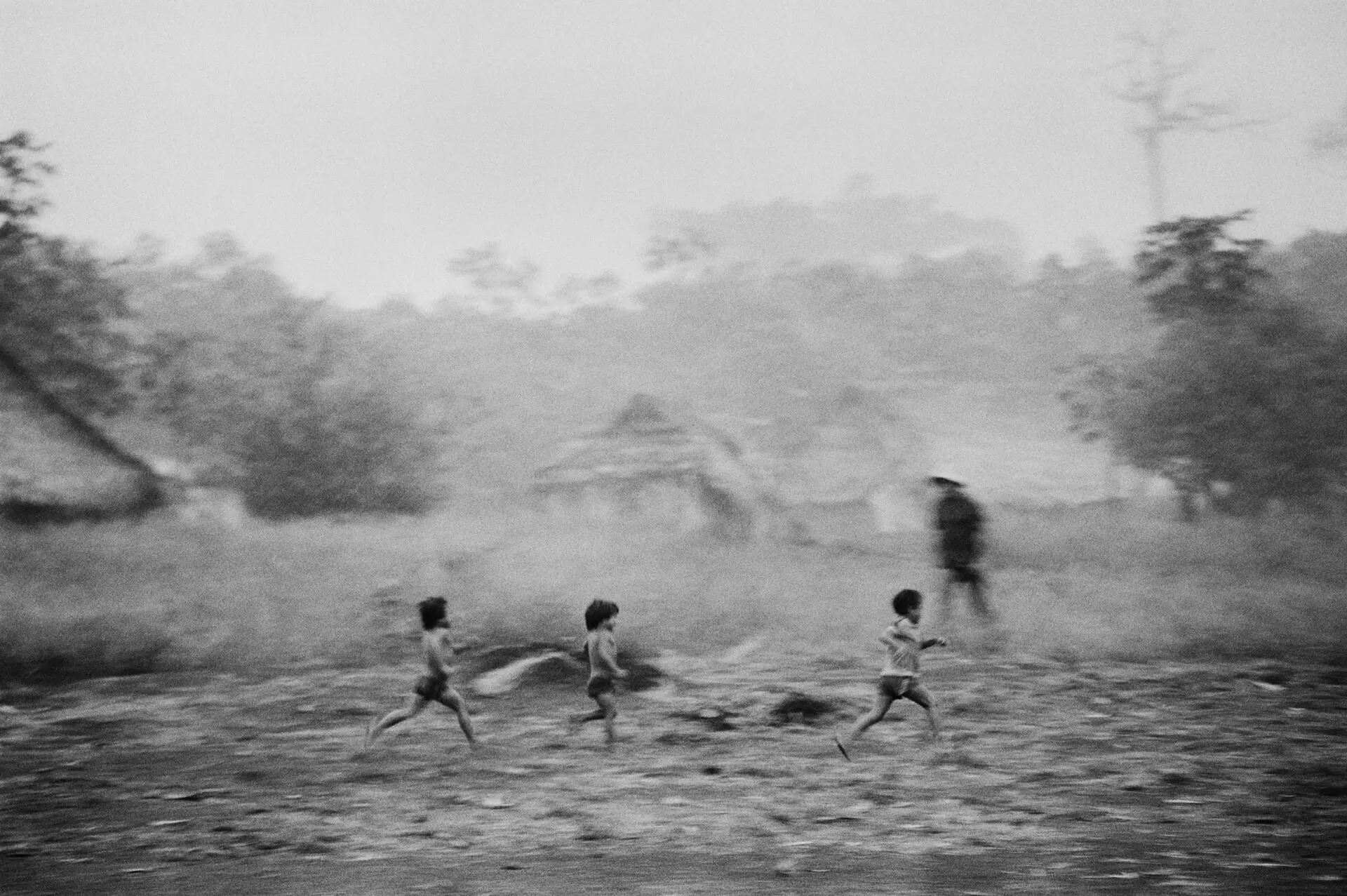
A picture of a normal day in 1989: kids playing in Apyterewa Village, in the state of Pará, in the Brazilian Amazon. Photo: Carlos Fausto





